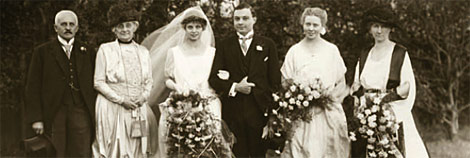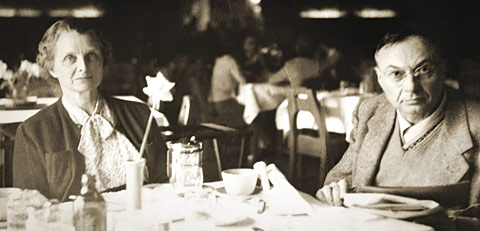|
|
WHO IS L.E.HUDEC
|
WHO IS LADISLAV HUDEC?
The film features fascinating story of the famous Shanghai’s architect and hitherto unknown contexts and relations in which the individual architectonic work were created.
 Ladislav Edvard Hudec/ Laszlo Ede Hugyecz was born on January 8, 1893 in Banska Bystrica in Slovakia, at the time when Slovakia formed a part of the Austro-Hungarian monarchy. Hudec grew up in the time when there was a ban on the teaching of Slovak at schools in the early 20th century, and the efforts to Magyarize (Hungarization) the Slovak intelligentsia were culminating. A good command of the Hungarian language and ”Hungarian-sounding name“ was inevitable if one wanted to enter civil service or start up a business. 1890 his father changed original Slovak name “Hudec” to the Hungarian form “ Hugyecz” by means of a simple transcription, which retained the original Slovak pronunciation. Ladislav Edvard Hudec/ Laszlo Ede Hugyecz was born on January 8, 1893 in Banska Bystrica in Slovakia, at the time when Slovakia formed a part of the Austro-Hungarian monarchy. Hudec grew up in the time when there was a ban on the teaching of Slovak at schools in the early 20th century, and the efforts to Magyarize (Hungarization) the Slovak intelligentsia were culminating. A good command of the Hungarian language and ”Hungarian-sounding name“ was inevitable if one wanted to enter civil service or start up a business. 1890 his father changed original Slovak name “Hudec” to the Hungarian form “ Hugyecz” by means of a simple transcription, which retained the original Slovak pronunciation.
|
|
 His father Gyorgy Hugyecz/ Juraj Hudec was leading master builder, architect, and contractor in the region. In the end of 19th century he even participated in the construction in the reinforced concrete tunnel of the Millennium underground in Budapest, the first underground in Europe. As a schoolboy Ladislav spent all his summers on the construction works of his father. During his grammar school studies, he acquired three different certificates of apprenticeship, where he mastered the professions of bricklayer, stonemason and carpenter. His father Gyorgy Hugyecz/ Juraj Hudec was leading master builder, architect, and contractor in the region. In the end of 19th century he even participated in the construction in the reinforced concrete tunnel of the Millennium underground in Budapest, the first underground in Europe. As a schoolboy Ladislav spent all his summers on the construction works of his father. During his grammar school studies, he acquired three different certificates of apprenticeship, where he mastered the professions of bricklayer, stonemason and carpenter.
In 1910 Hudec enrolled in the Technical University in Budapest.
|

|
Hudec’s First Work
Director Ladislav Kabos succeeded in tracing Hudec’s very first building. A small chapel of Our Lady the Queen at Vyhne, Slovak Republic, is his only architectural project outside of China. Blueprints and sketches were discovered in the archives of the Victoria University. Hudec’s authentic handwriting on a postcard (Hudec’s family archives) proves this.
|
|

|

|
World War I
 As a patriotic Austro-Hungarian citizen, Hudec volunteered to join the army after outbreak of World War I. Young engineer with university degree experienced real horrors of WWI. During Brusilov offensive, 1916 Hudec’s division near the city Luck received a command to withdraw to north-west direction. They got in the back of the enemy. Cossacks attacked them and Hudec collapsed of the blow on the head. He spent certain time in the field hospital and later he was directed to Siberia to Khabarovsk, where he was put into a officer prisoner camp with more then 3000 other persons. As a patriotic Austro-Hungarian citizen, Hudec volunteered to join the army after outbreak of World War I. Young engineer with university degree experienced real horrors of WWI. During Brusilov offensive, 1916 Hudec’s division near the city Luck received a command to withdraw to north-west direction. They got in the back of the enemy. Cossacks attacked them and Hudec collapsed of the blow on the head. He spent certain time in the field hospital and later he was directed to Siberia to Khabarovsk, where he was put into a officer prisoner camp with more then 3000 other persons.
|
|
Then he was prisoned in the camp Krasnaya Rechka. During the war Hudec was able to learn himself Polish, Russian, French and English. 1917 he got goal-fever. “…as a result of a fall I broke my leg…since my right leg became shorter as a result of the medical treatment…” Hudec wrote. He was a Hungarian prisoner with Hungarian sounding name and he experienced Czech legions looking for prisoners who were either executed or those having Czech or Slovak name were forced to join the Czech legion. Lazslo Hugyecz had only one chance how to save his life: to escape…
|

|
Golden Age of Architecture in Shanghai
Architect L.E.Hudec came to Shanghai from Harbin following his successful escape from Siberia.
At that time, Shanghai was a political and cultural centre as well as a city of vice and its reputation for being “The Paris of the East” was wholly justified. With a population of 2.5 million, Shanghai was then the fourth largest city in the world. Hudec lived in Shanghai during the city’s occupation by the British, American and French. These three cultures were relegated to separate foreign trade concessions, each governed by the laws of those individual Western countries. Neither the Chinese police nor the army ever entered into these areas.

|
|
In the multi-cultural city he received a job very quickly. He worked as a designer in the office of the American architect R.A.Curry since November 1918. Talented Hudec became an office manager, later he was even an “associated architect” of the company R.A. Curry.

In 1922 Hudec married Gizela Mayer who was born in Shanghai and came from a very wealthy family. Her father, a German Businessman and Lutheran and her mother, Née Tisdall, who came to China from Scotland only spoke English and German in the household. |

|


1925 he managed to build his own prestigious company L.E.HUDEC. He used again his Slovak transcription of family name. During 28 years he designed and built more then 60 buildings of which almost one half has survived to this day, and most of these have become cultural heritage.

Thanks to Hudec we can find neo-classicism, neo-gothic style, art novae, art deco, and first of all functionalism and modernism in Shanghai.
|
|
 The name of L.E.Hudec, which enjoys great respect in Asia, is a household name in Shanghai: after all, he built the first air-conditioned hospital in the city, the first brewery, the first modern appartments, designed three important buildings in the prestigious People’s Square (including the first movie theatre Grand Theatre, sacral architecture Moore Memorial Church, Park Hotel) and became “the father of modern high rises”. The name of L.E.Hudec, which enjoys great respect in Asia, is a household name in Shanghai: after all, he built the first air-conditioned hospital in the city, the first brewery, the first modern appartments, designed three important buildings in the prestigious People’s Square (including the first movie theatre Grand Theatre, sacral architecture Moore Memorial Church, Park Hotel) and became “the father of modern high rises”.
The world famous architect I. M. Pei once said that his dream of being architect was inspired by his sight of the Park Hotel under construction. In the years 1933-1934, architect Ladislav Hudec built in Shanghai the first high-rise building – the 22-storey Park Hotel, for long decades Asia’s highest building. Having used a modern entirely steel construction, the architect solved the technological solution of the structure erected in difficult geological conditions in marshy subsoil. As a matter of record, Park Hotel set the stage for the city’s new planning and developments, and paved the way for the current projects by today’s developers. Hudec’s works are analysed and discussed in many publications devoted to the history of modern world architecture.
|

|
World War II
1921 – 1941 Hudec and his children used Czechoslovakian passports. In 1938, Czechoslovakia was disintegrated after the Munich Agreement. Hudec aplied for Hungarian citizenship. In 1941, the Japanese occupied Shangai´s foreign districts, stripping the Western inhabitants of both their privileges and livehood. Martin Hudec, the oldiest son of the architect says: “The Japanese controlled everything. But we were able to continue our lives. My father, of course, couldn’t work anymore because the Japanese wouldn’t allow you to build buildings.”
|
|
The other son of L.E.Hudec, Theo, describes the conditions of life in Shanghai during WWII:
„It was quite normal to see a floating corpse go by. But when we went to school on our bicycles, you’d often see dead children, babies.. lying on the road. Often packed up in newspaper and often dogs would be eating it. Life was nothing ...“
|

|
Hudec Saving Lives of Jews
In 1941 Hudec obtained a Hungarian passport and was appointed Honorary Consul of Hungary in Shanghai. He used that post for saving Jewish families. His private secretary was a Jewish woman: “… if he weren’t a consul …140 Jewish citizens could have gone in the ghetto with the stateless.
They would have lost their existence…” 1946 Imre Koczard, dermatologist, wrote: “We Hungarian Jewish can thank to L.Hudec, Honorary Consul…
|
|
 that he risking his own personal safety he prevented us from the fate of the other Central European emigrants, from being sent to the ghetto”. There exist a number of letters written after the end of WWII by Jews to L.E.Hudec expressing their gratitude. that he risking his own personal safety he prevented us from the fate of the other Central European emigrants, from being sent to the ghetto”. There exist a number of letters written after the end of WWII by Jews to L.E.Hudec expressing their gratitude.
|

|
From China to USA
1947 Hudec and his family left China for Europe when the civil war broke out in the country. Developments after World War II – and especially the division of Berlin – evoked Hudec’s fears of the outbreak of a Third World War.
Hudec who already had some experience of Russian bolshevism decided for emigration to the United States.

|
|
The architect Hudec spent the last years of his active life in Berkeley teaching and researching early Christian philosophy and culture at Berkeley University of California. He participated in the research and archaeological excavations of the remains of St. Peter in Vatican. Had he wanted to work as an architect in the United States he would have had to obtain a necessary licence – but he lacked sufficient resolve for that at his age. He died of a heart attack at the age 65 at June 14th, 1958 in California, USA. At his express wish he was buried in Banska Bystrica.
The most important Hudec’s creation is “the bridge between Europe and Asia”. Hudec, who mastered 9 European languages, didn’t speak Chinese and he didn’t understand Chinese, but most of his clients were Chinese. Already in the early 20th century he proved that there are no obstacles in understanding inhabitants of distant countries, brought up in foreign culture and influenced by different traditions, religions and background. The obstacles and limits are only in our minds, in our fixed ideas.
|
|
|

 Ladislav Edvard Hudec/ Laszlo Ede Hugyecz was born on January 8, 1893 in Banska Bystrica in Slovakia, at the time when Slovakia formed a part of the Austro-Hungarian monarchy. Hudec grew up in the time when there was a ban on the teaching of Slovak at schools in the early 20th century, and the efforts to Magyarize (Hungarization) the Slovak intelligentsia were culminating. A good command of the Hungarian language and ”Hungarian-sounding name“ was inevitable if one wanted to enter civil service or start up a business. 1890 his father changed original Slovak name “Hudec” to the Hungarian form “ Hugyecz” by means of a simple transcription, which retained the original Slovak pronunciation.
Ladislav Edvard Hudec/ Laszlo Ede Hugyecz was born on January 8, 1893 in Banska Bystrica in Slovakia, at the time when Slovakia formed a part of the Austro-Hungarian monarchy. Hudec grew up in the time when there was a ban on the teaching of Slovak at schools in the early 20th century, and the efforts to Magyarize (Hungarization) the Slovak intelligentsia were culminating. A good command of the Hungarian language and ”Hungarian-sounding name“ was inevitable if one wanted to enter civil service or start up a business. 1890 his father changed original Slovak name “Hudec” to the Hungarian form “ Hugyecz” by means of a simple transcription, which retained the original Slovak pronunciation. His father Gyorgy Hugyecz/ Juraj Hudec was leading master builder, architect, and contractor in the region. In the end of 19th century he even participated in the construction in the reinforced concrete tunnel of the Millennium underground in Budapest, the first underground in Europe. As a schoolboy Ladislav spent all his summers on the construction works of his father. During his grammar school studies, he acquired three different certificates of apprenticeship, where he mastered the professions of bricklayer, stonemason and carpenter.
His father Gyorgy Hugyecz/ Juraj Hudec was leading master builder, architect, and contractor in the region. In the end of 19th century he even participated in the construction in the reinforced concrete tunnel of the Millennium underground in Budapest, the first underground in Europe. As a schoolboy Ladislav spent all his summers on the construction works of his father. During his grammar school studies, he acquired three different certificates of apprenticeship, where he mastered the professions of bricklayer, stonemason and carpenter.
 As a patriotic Austro-Hungarian citizen, Hudec volunteered to join the army after outbreak of World War I. Young engineer with university degree experienced real horrors of WWI. During Brusilov offensive, 1916
As a patriotic Austro-Hungarian citizen, Hudec volunteered to join the army after outbreak of World War I. Young engineer with university degree experienced real horrors of WWI. During Brusilov offensive, 1916 




 The name of L.E.Hudec, which enjoys great respect in Asia, is a household name in Shanghai: after all, he built the first air-conditioned hospital in the city, the first brewery, the first modern appartments, designed three important buildings in the prestigious People’s Square (including the first movie theatre Grand Theatre, sacral architecture Moore Memorial Church, Park Hotel) and became “the father of modern high rises”.
The name of L.E.Hudec, which enjoys great respect in Asia, is a household name in Shanghai: after all, he built the first air-conditioned hospital in the city, the first brewery, the first modern appartments, designed three important buildings in the prestigious People’s Square (including the first movie theatre Grand Theatre, sacral architecture Moore Memorial Church, Park Hotel) and became “the father of modern high rises”.
